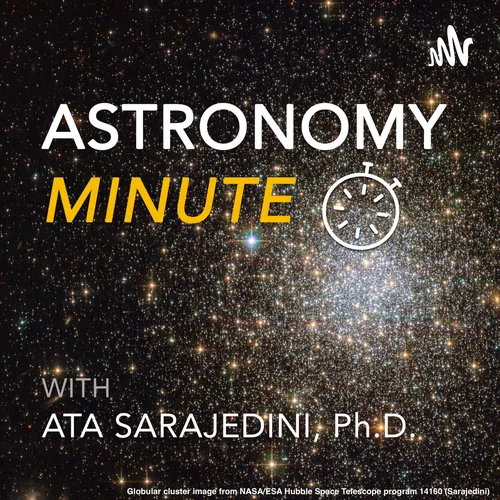
Astronomy Minute
Learn the basics of astronomy in one-to-two minute packets of concise information about specific topics. You are a busy person with a short attention span, and you want to learn about astronomical topics in a short amount of time. Your host Professor Ata is a PhD research astronomer and astrophysicist and a noted authority on stellar and galactic astronomy. I welcome your feedback at [email protected]. See the web site astronomyminute.org for more. The podcast logo is courtesy of Zachary Greathouse and shows a globular cluster photo taken by the author with the Hubble Space Telescope.
- Update frequency
- every 3 days
- Average duration
- 1 minutes
- Episodes
- 183
- Years Active
- 2020 - 2023

The Clockwork of the Universe
A brief description of how the motion of the Moon around the Earth, the Earth around the Sun, the Sun around the center of our galaxy, and the motion of the galaxy itself are like clockwork.

What do I Need to Know About Johannes Kepler?
A brief description of Johannes Kepler's main contributions to astronomy.

What do I Need to Know About Tycho Brahe?
A brief description of Tycho Brahe's contributions to astronomy.

What do I Need to Know About Nicolaus Copernicus?
A brief description of the basic contributions Nicolaus Copernicus made to the science of astronomy.

How do We Know There are Planets Around Other Stars?
A brief description of the techniques we use to detect the presence of planets orbiting around other stars besides the Sun. These techniques are known as Transit Photometry and Doppler Spectroscopy.

What is Meant by a Bell Curve?
A brief description of the definition of a Bell Curve - also known as a Normal Distribution and a Gaussian Distribution; it is very important in the fields of statistics and probability.

What are Right Ascension and Declination?
A brief description of Right Ascension and Declination and how they are used to locate objects in the sky.

What Causes the Phases of the Moon?
A brief description of what causes the phases of the Earth's Moon. An animation/movie linked off of the web page helps to explain the podcast.

What Causes the Seasons on the Earth?
A brief description of what doesn't cause the seasons and what we actually believe does cause them. There is also a graphic linked off the web page that helps explain this episode.

What is the Difference Between Precision and Accuracy?
A brief description of the difference between precision and accuracy in astronomy.

What is Meant by an Order of Magnitude and a Logarithmic Scale?
A brief description of what we mean when we say that two numbers differ by an order to magnitude. This includes a summary of what a Logarithmic is.

Where are the Sun's Siblings?
A brief description of why we expect the Sun to have been formed in a multiple star system and how we are searching for the other stars formed with it.

What is the Difference Between Random Errors and Systematic Errors?
A brief description of the difference between random errors and systematic errors in science.

What is Meant by the Magnitude System?
A brief description of the magnitude system in astronomy including the difference between apparent magnitude and absolute magnitude.

What is the Kelvin Temperature Scale?
A brief description of the Kelvin temperature scale as compared with Fahrenheit and Celsius.

What are Comets and Meteor Showers?
A brief description of what comets are and how they are responsible for meteor showers on the Earth.

What is the Cosmic Microwave Background?
A brief description of the Cosmic Microwave Background (CMB) also known as the Primordial Background Radiation.

How Do We Classify Stars?
A brief description of how we classify stars based on their surface temperatures.

What is Meant by Hierarchical Clustering in Astronomy?
A brief description of the concept of hierarchical clustering in astronomy.

What is the Interstellar Medium?
A brief description of the main components of the interstellar medium, which is the stuff in space between the stars.